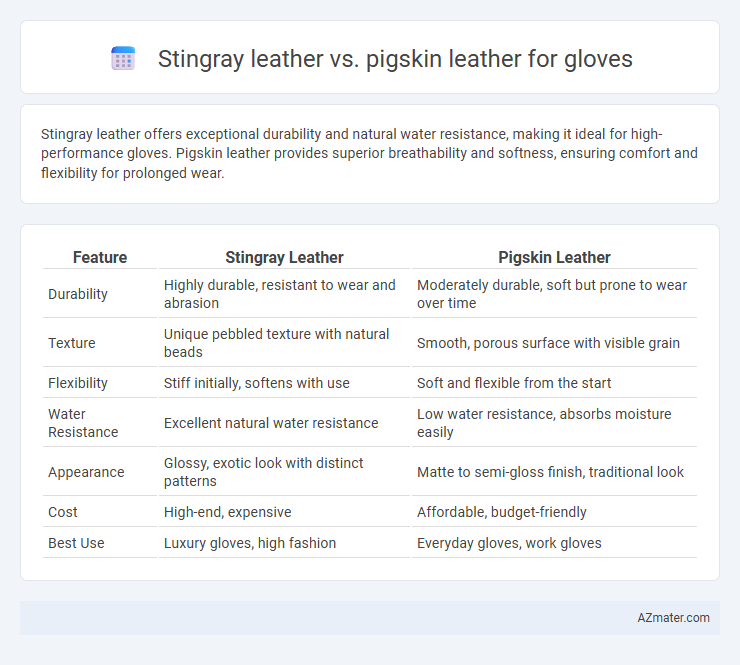Stingray leather offers exceptional durability and natural water resistance, making it ideal for high-performance gloves. Pigskin leather provides superior breathability and softness, ensuring comfort and flexibility for prolonged wear.
Table of Comparison
| Feature | Stingray Leather | Pigskin Leather |
|---|---|---|
| Durability | Highly durable, resistant to wear and abrasion | Moderately durable, soft but prone to wear over time |
| Texture | Unique pebbled texture with natural beads | Smooth, porous surface with visible grain |
| Flexibility | Stiff initially, softens with use | Soft and flexible from the start |
| Water Resistance | Excellent natural water resistance | Low water resistance, absorbs moisture easily |
| Appearance | Glossy, exotic look with distinct patterns | Matte to semi-gloss finish, traditional look |
| Cost | High-end, expensive | Affordable, budget-friendly |
| Best Use | Luxury gloves, high fashion | Everyday gloves, work gloves |
Introduction to Stingray Leather and Pigskin Leather
Stingray leather is renowned for its exceptional durability, unique pebble-like texture, and natural water resistance, making it an ideal choice for high-performance gloves. Pigskin leather, on the other hand, is prized for its softness, breathability, and pliability, offering enhanced comfort and flexibility in glove construction. Both materials provide distinct advantages, with stingray excelling in wear resistance and pigskin favored for superior grip and tactile sensitivity.
Unique Characteristics of Stingray Leather
Stingray leather features a distinctive, pebbled texture with natural calcium deposits that create a unique, durable surface resistant to scratches and water, making it highly suitable for premium gloves. Its dense fiber structure offers superior strength and longevity compared to pigskin leather, which is softer and more supple but less abrasion-resistant. The natural iridescence and exotic appearance of stingray leather provide an exclusive aesthetic appeal, enhancing the luxury and durability of gloves crafted from this material.
Distinct Properties of Pigskin Leather
Pigskin leather is renowned for its exceptional breathability and softness, making it a preferred choice for gloves that require both comfort and flexibility. Its tight grain structure offers natural durability while maintaining a lightweight feel, allowing for excellent dexterity during use. Unlike stingray leather, pigskin is more pliable and easier to break in, providing a glove that adapts quickly to hand movement and offers superior moisture absorption.
Durability Comparison: Stingray vs Pigskin
Stingray leather exhibits exceptional durability due to its dense, pebble-like surface that resists abrasion and tearing, making it ideal for high-wear gloves. Pigskin leather offers good durability with natural oils that enhance flexibility and water resistance but tends to wear down faster under heavy use compared to stingray. Compared to pigskin, stingray leather provides superior longevity and toughness, especially in demanding environments.
Comfort and Flexibility: Which Leather Excels?
Stingray leather offers superior durability and unique texture but tends to be stiffer and less flexible compared to pigskin leather, which is renowned for its softness and exceptional flexibility, making it more comfortable for glove wearers. Pigskin's natural fibers allow for better breathability and adaptability to hand movements, enhancing comfort during prolonged use. For gloves prioritizing comfort and flexibility, pigskin leather typically excels over stingray leather.
Water Resistance and Weather Performance
Stingray leather offers superior water resistance compared to pigskin leather, making it an excellent choice for gloves exposed to wet conditions. Its dense, natural epidermal structure prevents moisture penetration, maintaining durability and flexibility in various weather environments. Pigskin leather, while breathable and comfortable, tends to absorb water more easily, which can affect its performance and longevity in consistently damp or harsh weather.
Aesthetic Appeal and Texture Differences
Stingray leather for gloves offers a unique aesthetic appeal with its distinctive pebble-like texture and natural glossy finish, creating a luxurious and exotic look that stands out. Pigskin leather, in contrast, provides a softer, more supple texture with a matte appearance, delivering a classic and understated elegance. The pronounced grain of stingray leather contrasts sharply with the fine, uniform grain of pigskin, making each glove visually and tactilely distinct.
Maintenance and Care Requirements
Stingray leather gloves require minimal maintenance due to their natural water resistance and durability, needing only occasional wiping with a damp cloth to remove dirt and avoid drying out. Pigskin leather gloves demand more frequent conditioning with leather-specific products to maintain softness and prevent cracking, especially after exposure to moisture or sweat. Both types benefit from proper storage away from direct sunlight and excessive humidity to extend glove longevity and preserve material integrity.
Price and Availability in the Glove Market
Stingray leather gloves are considerably more expensive than pigskin leather gloves due to the rarity and unique texture of stingray hide, often priced two to three times higher. Pigskin leather gloves are widely available and favored for their affordable price and durability, making them a popular choice among budget-conscious consumers. Market availability favors pigskin leather gloves due to easier sourcing and processing compared to the limited and more specialized supply of stingray leather.
Choosing the Right Leather for Your Gloves
Stingray leather offers exceptional durability and water resistance, making it ideal for gloves requiring high abrasion protection and longevity. Pigskin leather provides superior breathability and soft flexibility, preferred for gloves needing comfort and dexterity. Selecting between stingray and pigskin leather depends on balancing toughness and tactile sensitivity based on the glove's intended use.

Infographic: Stingray leather vs Pigskin leather for Glove
 azmater.com
azmater.com